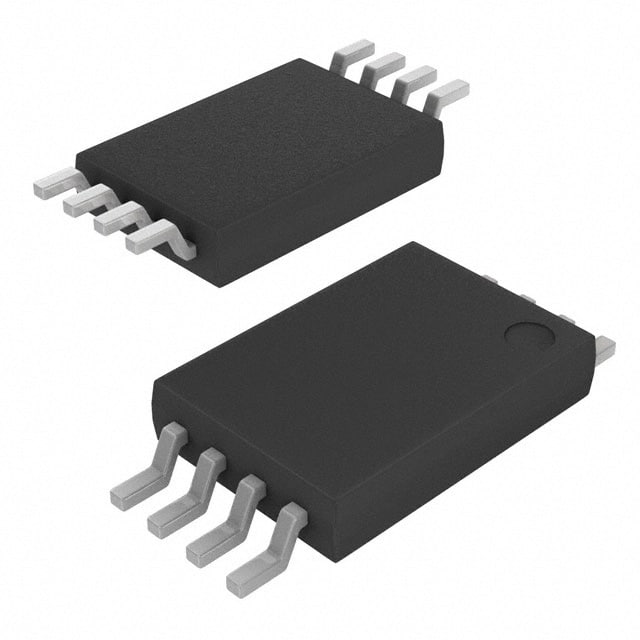Xem thông số kỹ thuật để biết chi tiết sản phẩm.

X9317WV8IT1
Product Overview
- Category: Integrated Circuit (IC)
- Use: Digital Potentiometer
- Characteristics: Non-volatile, 100 Taps, I2C Interface
- Package: SOIC-8
- Essence: Provides adjustable resistance in electronic circuits
- Packaging/Quantity: Tape and Reel, 2500 units per reel
Specifications
- Resistance Range: 0 to 10kΩ
- Number of Taps: 100
- Interface: I2C
- Supply Voltage: 2.7V to 5.5V
- Operating Temperature Range: -40°C to +85°C
Detailed Pin Configuration
The X9317WV8IT1 has a total of 8 pins arranged as follows:
```
| | | 1 2 | | 3 4 | | 5 6 | | 7 8 | |___________| ```
- VCC: Supply Voltage
- SDA: Serial Data Input/Output
- SCL: Serial Clock Input
- GND: Ground
- A0: Address Bit 0
- A1: Address Bit 1
- WP: Write Protect
- H/L: High/Low Terminal
Functional Features
- Non-volatile memory stores wiper position during power-off
- 100 tap points provide fine-grained resistance adjustment
- I2C interface allows easy digital control
- Low power consumption for energy-efficient applications
- Compact SOIC-8 package for space-constrained designs
Advantages and Disadvantages
Advantages
- Non-volatile memory ensures settings are retained even without power
- Fine-grained adjustment with 100 tap points allows precise resistance tuning
- Digital control via I2C interface simplifies integration into digital systems
- Low power consumption makes it suitable for battery-powered devices
- Compact package enables use in space-constrained applications
Disadvantages
- Limited resistance range of 0 to 10kΩ may not be suitable for all applications
- Requires I2C communication capability in the host system
- Not suitable for high-power applications due to its small package size
Working Principles
The X9317WV8IT1 is a digital potentiometer that operates based on the principle of resistive voltage division. It consists of a series of resistive elements connected between the VCC and GND pins. The wiper terminal, controlled by the internal circuitry, taps onto these resistive elements to provide an adjustable resistance.
The position of the wiper determines the effective resistance between the H/L terminal and the wiper terminal. By controlling the wiper position digitally through the I2C interface, the resistance can be adjusted to the desired value.
Detailed Application Field Plans
The X9317WV8IT1 finds applications in various fields, including:
- Audio Equipment: Used for volume control and tone adjustment in audio amplifiers and mixers.
- Industrial Automation: Provides resistance adjustment in control circuits for precise calibration.
- Test and Measurement Instruments: Enables programmable resistance for testing and calibration purposes.
- Consumer Electronics: Used in devices such as TVs, set-top boxes, and gaming consoles for user-controlled settings.
- Automotive Electronics: Allows resistance adjustment in automotive systems like climate control and lighting.
Detailed and Complete Alternative Models
- MCP401X: Microchip Technology's digital potentiometer series with similar specifications.
- AD525X: Analog Devices' digital potentiometer series offering extended resistance range.
- MAX54X: Maxim Integrated's digital potentiometer series with additional features like temperature compensation.
These alternative models provide similar functionality and can be considered based on specific application requirements.
Word count: 530 words
Liệt kê 10 câu hỏi và câu trả lời thường gặp liên quan đến ứng dụng X9317WV8IT1 trong giải pháp kỹ thuật
Sure! Here are 10 common questions and answers related to the application of X9317WV8IT1 in technical solutions:
Q1: What is X9317WV8IT1? A1: X9317WV8IT1 is a digital potentiometer, also known as a digipot. It is an integrated circuit that can be used to digitally control resistance in electronic circuits.
Q2: What are the key features of X9317WV8IT1? A2: The key features of X9317WV8IT1 include 100kΩ resistance range, 256 tap points, low power consumption, non-volatile memory, and compatibility with both serial and parallel interfaces.
Q3: How can X9317WV8IT1 be used in technical solutions? A3: X9317WV8IT1 can be used in various applications such as audio equipment, instrumentation, voltage regulators, motor control, and other systems where precise resistance adjustment is required.
Q4: How does X9317WV8IT1 communicate with the microcontroller or host system? A4: X9317WV8IT1 communicates using either a serial interface (SPI) or a parallel interface. The choice depends on the specific requirements of the application.
Q5: Can X9317WV8IT1 store its settings even when powered off? A5: Yes, X9317WV8IT1 has non-volatile memory, which means it can retain its settings even when power is removed. This feature is useful for applications where the resistance value needs to be preserved across power cycles.
Q6: What is the resolution of X9317WV8IT1? A6: X9317WV8IT1 has a resolution of 256 tap points, meaning it can provide 256 discrete resistance values within its specified range.
Q7: What is the power supply voltage range for X9317WV8IT1? A7: The power supply voltage range for X9317WV8IT1 is typically between 2.7V and 5.5V, making it compatible with a wide range of systems.
Q8: Can X9317WV8IT1 handle high currents? A8: No, X9317WV8IT1 is designed for low-power applications and cannot handle high currents. It is recommended to use external amplifiers or buffers if higher current handling is required.
Q9: Is X9317WV8IT1 suitable for automotive applications? A9: Yes, X9317WV8IT1 is suitable for automotive applications as it meets the necessary requirements for temperature range, reliability, and robustness.
Q10: Are there any evaluation boards or development kits available for X9317WV8IT1? A10: Yes, several evaluation boards and development kits are available from the manufacturer, which can help in prototyping and testing X9317WV8IT1 in different applications.
Please note that the answers provided here are general and may vary depending on the specific implementation and requirements of your technical solution.

